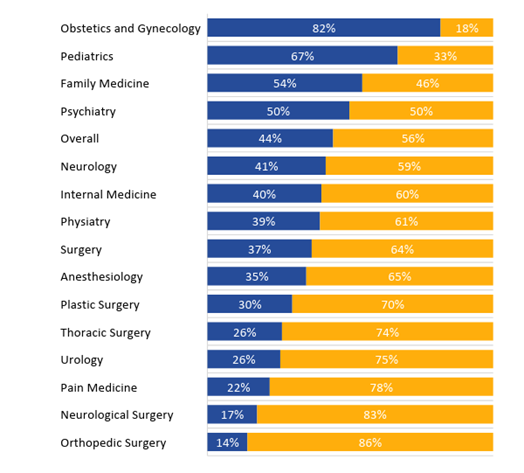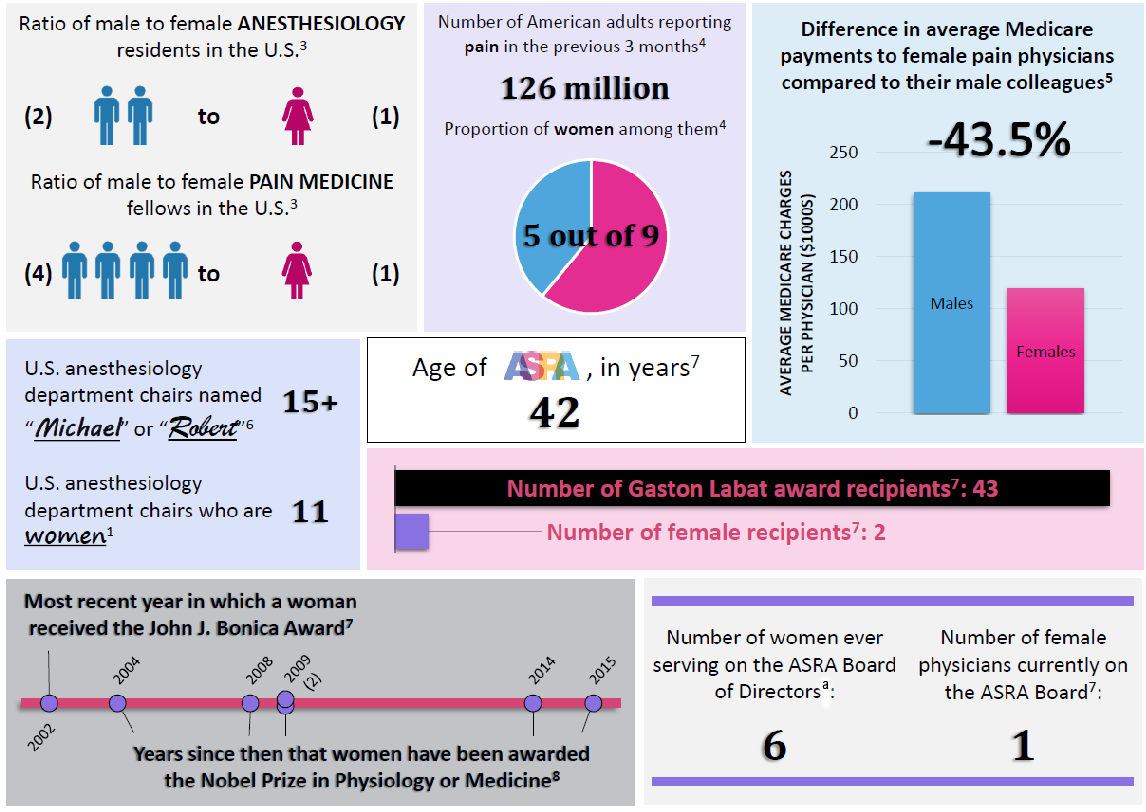Supporting Women in Regional Anesthesia and Pain Medicine (WRAPM): Why You Should Join the ASRA Special Interest Group
The Gender Gap in Regional Anesthesia and Pain Medicine
In 1965, fewer than 10% of medical students were female; now, more than five decades later, women comprise approximately half of all medical school graduates.[1] Despite the increased representation of women in the physician workforce, a significant gender gap persists in many medical specialties—including anesthesiology and particularly in the subspecialty of pain medicine. Although approximately 1 in 10 United States physicians is an anesthesiologist,[2] women comprise just 35% of anesthesiology residents and 22% of pain medicine fellows.[3] To place that into context, anesthesiology has a lower proportion of female trainees than internal medicine, physiatry, or surgery, and pain medicine has proportionally fewer female trainees than plastic surgery, thoracic surgery, or urology (Figure 1).[3] More importantly, the underrepresentation of women in our profession goes beyond the mere number of trainees and extends into every aspect of our careers, including compensation, awards recognition, and leadership positions (Figure 2). With the creation of the newest ASRA Special Interest Group (SIG), we intend to address this problem—together. Women in Regional Anesthesia and Pain Medicine (WRAPM) is a free SIG open to all ASRA members, men and women, interested in supporting and advancing the role of women in our subspecialties and medicine in general.
“The underrepresentation of women in our profession goes beyond the mere number of trainees and extends into every aspect of our careers, including compensation, awards recognition, and leadership positions.”

Figure 1: Gender composition of trainees in selected ACGME specialties, 20164

Figure 2. Women in Regional Anesthesia and Pain Medicine: By the Numbers
WRAPM'S Mission
- Encourage recruitment and promote the contributions of women in regional anesthesiology and pain medicine.
- Provide networking opportunities and professional development support for women in pursuit of ASRA's mission.
- Recognize the achievements of women in the field and understand the unique challenges that women in the profession face.
As one of the foremost professional societies in our specialty, ASRA is in a powerful position to effect positive change in the science and practice of regional anesthesia and pain medicine. Improving gender diversity will drive more innovative research, more comprehensive education, and more personalized patient care. When we encourage and promote the participation of women in our profession, we are helping ASRA to “accomplish our mission and vision by addressing the clinical and professional educational needs of physicians and scientists, ensuring excellence in patient care utilizing regional anesthesia and pain medicine, and investigating the scientific basis of the specialty.”
To accomplish the shared missions of ASRA and WRAPM, we have proposed the following goals and objectives:
- Provide a networking forum for women in ASRA to discuss and share ideas to enhance their professional development.
- Provide mentorship, sponsorship, and support to women in the early phases of careers in regional anesthesiology and pain medicine.
- Offer specific leadership training for women, with an emphasis on developing a pathway for advancement in ASRA as well as individual academic and private institutions.
- Support research projects from women in regional anesthesiology and pain medicine.
- Increase participation of female medical students, residents, and fellows in the field.
- Recognize and promote the work of women in advancing the field through education, advocacy, research, and patient care.
- Advise ASRA on issues related to women in the practice of regional anesthesiology and pain medicine.
How You Can Help
The WRAPM SIG aims to benefit all ASRA members, leveraging the excellent resources and tools that ASRA provides. We invite men and women at all levels of training to join us. We want to learn from our trainees and early career professionals what services and support we can provide to promote successful careers. We seek the mentorship and sponsorship of successful male and female physicians to help us identify professional development strategies that work and how we can use them to promote women in regional anesthesia and pain medicine. We want to learn from residency and fellowship program directors about the barriers that prevent women from pursuing our profession, ways to address them, and steps we can take to encourage greater female interest. We need division chiefs, department chairs, conference organizers, journal editors, and awards committee members to join in the discussion on how we can elevate the profiles of women in regional anesthesia and pain medicine. We value the perspectives of our male and female advocates, sponsors, and mentors to understand how we can work together to improve gender diversity and effect positive change in our specialty.
In short, if you're an ASRA member, WRAPM needs your help—and wants to help you! Please join us, and together, we can create new opportunities to advance the role of women in regional anesthesiology and pain medicine. We can't wait to see all of you at our next meeting at the 2018 World Congress on Regional Anesthesia and Pain Medicine in New York!
References
- Association of American Medical Colleges. The state of women in academic medicine: the pipeline and pathways to leadership, 2015–2016. Available at: https://www.aamc.org/members/gwims/statistics/. Published 2016. Accessed November 2, 2017.
- The Henry J. Kaiser Family Foundation. Providers and service use indicators. Available at: https://www.kff.org/state-category/providers-service-use/. Accessed November 8, 2017.
- Accreditation Council for Graduate Medical Education. Data Resource Book, Academic Year 2016–2017. Chicago, Illinois: Accreditation Council for Graduate Medical Education; 2017. Available at: http://www.acgme.org/Portals/0/PFAssets/PublicationsBooks/2016-2017_ACGME_DATABOOK_DOCUMENT.pdf. Accessed March 22, 2018.
- Nahin RL. Estimates of pain prevalence and severity in adults: United States. 2012. J Pain 2015;16(8):769–780.
- Mahr MA, Hayes SN, Shanafelt TD, Sloan JA, Erie JC. Gender differences in physician service provision using medicare claims data. Mayo Clin Proc 2017;92(6):870–880.
- Google. Google search. http://www.google.com. Accessed November 21, 2017.
- American Society of Regional Anesthesiology and Pain Medicine. American Society of Regional Anesthesia and Pain Medicine website. http://www.asra. com. Accessed November 21, 2017.
- Nobel Prize. All Nobel Prizes in physiology or medicine. Available at: https://www.nobelprize.org/nobel_prizes/medicine/laureates/. Accessed November 21, 2017.
Leave a commentOrder by
Newest on top Oldest on top